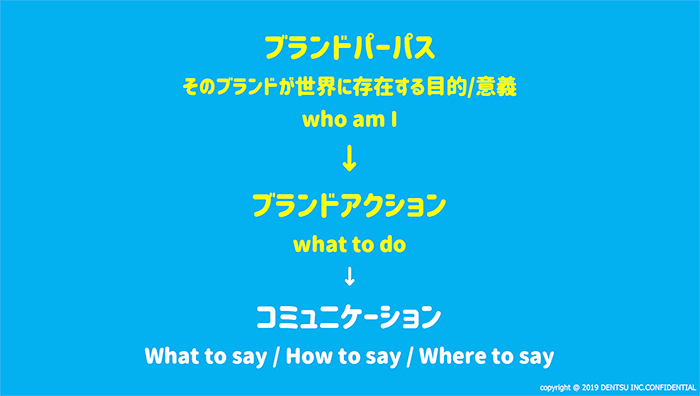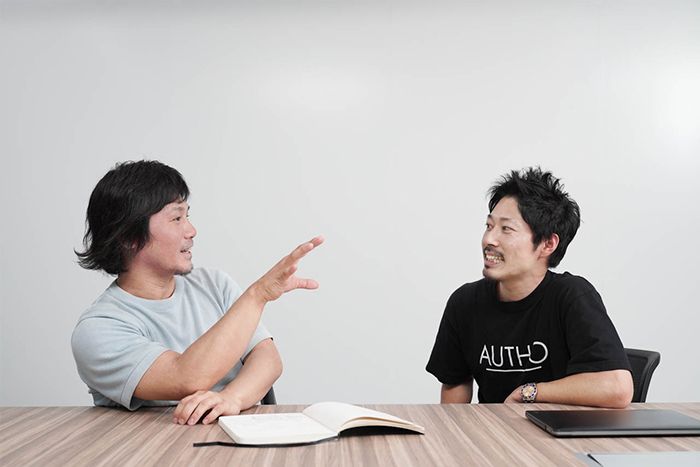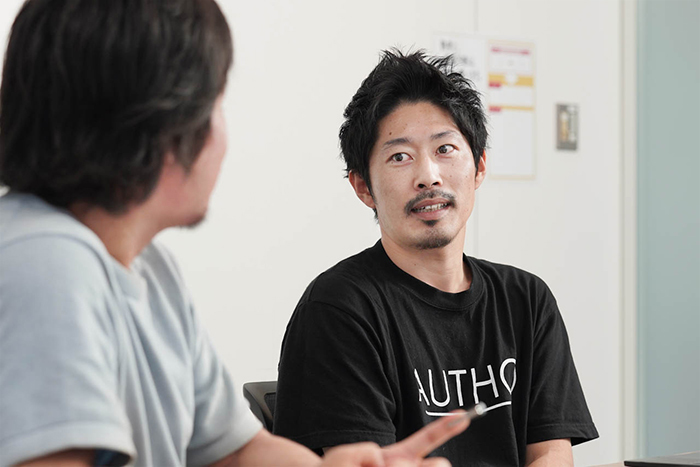Dentsu Inc.'s cross-functional creative organization, the Future Creative Center (FCC), is a group that supports the creation of the future with creativity, transcending the boundaries of advertising. This series introduces actual initiatives under the theme "Future × Creativity."
The scope for utilizing creative ideas continues to expand. While such ideas were primarily used in "advertising" until now, in recent years they have been incorporated into corporate business activities and management itself.
For example, Isehan's " Face-Based Hiring " initiative for this year's recruitment campaign. Their attempt to invite candidates to interviews in their own unique, free-spirited makeup and attire became a major talking point. Or, the "Family Harmony Job Change Support Tool " prepared by the Hokkaido Nippon-Ham Fighters professional baseball team for mid-career hires. Recognizing that the decision to relocate to Hokkaido is often the biggest hurdle when changing jobs, they provided presentation materials to help gain family understanding.
These are examples where creators designed the very framework of corporate recruitment activities. Mr. Noritaka Obuse (Group Creative Director, Creative Planning Division 3) and Mr. Shunta Yoshikawa (Communication Planner, Creative Planning Division 2) of Dentsu Inc., who handled these projects, believe that 'initiative-driven creativity' – weaving creative ideas into corporate and human activities – will hold value going forward. They discussed the reasons for this in a dialogue.

(From left) Noritaka Obuse (Creative Planning Division 3), Shunta Yoshikawa (Creative Planning Division 2)
Incorporating Corporate DNA into Recruitment: Isehan's "Face-Based Hiring"
Yoshikawa: Just seeing Nobutaka here tells me what today's topic will be (laughs).
Obuse: We often work on the same projects and frequently discuss work. Lately, we've been talking a lot about how to leverage creativity. Traditionally, creativity meant injecting ideas into advertising communications, but we're exploring whether we can also inject ideas into the company's business activities and management policies themselves—into the "efforts" themselves.
Yoshikawa: That's right, we talked about it endlessly at our drinking spot too (laughs).
Obuse: We call this "Initiative Creativity." I wanted to discuss its potential here. So, first off, could you start with "Face-Based Hiring," Yoshikawa?

Isehan: "We're starting facial recognition hiring."
Yoshikawa: "Face-Based Hiring" didn't mean judging applicants by their looks. It was an initiative encouraging them to come to interviews wearing their favorite makeup or clothes, expressing their true selves. While job hunting often means standard "job-hunting makeup" like black hair and light makeup, we welcomed anything that felt like their authentic self—whether full makeup or bare-faced. We also required applicants to submit a photo expressing their "true self" as part of the application, asking them to tell their story through that photo. We even made it possible to apply via Instagram.
Obuse: How did you arrive at this idea for the recruitment activity?
Yoshikawa: We weren't planning recruitment activities from the start; it was more that we arrived at this concept as we discussed the overall idea.
Isehan carries the brand message "For those who love their true self." We were thinking of ways to make this message more widely known. Isehan had the challenge of promoting its innovative DNA as a long-established company – being the first in Japan to introduce self-makeup counters and the first cosmetics company to run color ads in newspapers.
Around that time, a debate was brewing in society about whether "women's makeup is a matter of etiquette." We wanted Isehan to convey the message: "We believe makeup isn't etiquette; it's an expression of your true self." But we discussed whether there was a way to spark more public discussion than just a regular ad. That's how we arrived at the idea of changing the recruitment system itself – leading to the 'Face Recruitment' campaign.
Obuse: It really did generate a huge response, didn't it?
Yoshikawa: It was featured on Yahoo! News the morning we announced it, and starting the next day, commercial TV stations and NHK picked it up. After that, promotional interviews kept coming, and the information spread rapidly. Ultimately, through this initiative, we successfully conveyed Isehan's core corporate philosophy: "To those who can love their true selves."
Using creative power to make corporate activities newsworthy
Obuse: The Fighters project I worked on was for mid-career hiring to build the new home stadium, "Hokkaido Ballpark," replacing Sapporo Dome. However, simply posting job listings on career sites would only reach people already interested in this project. Since it also involves community development beyond just sports, the goal was to reach a much broader audience.

Hokkaido Nippon-Ham Fighters "Family Harmony Job Change Support Tool"
Some candidates might need to relocate to Hokkaido for the job. The biggest hurdle is getting family approval. So, we thought: why not provide a tool to help convince them? We created a customizable PowerPoint presentation deck to showcase the job's value and the appeal of living in Hokkaido, available for download. The unique concept itself – the Fighters creating a "serious proposal deck" to win over families – became newsworthy. We calculated that this would spread awareness of the mid-career hiring opportunity.
In the Fighters' case, they have core fans who meticulously check all team-related information. We believed that reaching these people first would create the initial spark for the message to spread. Indeed, with over 5,000 applications received, I think awareness was higher than for a typical mid-career recruitment announcement.
Yoshikawa: The "Face Recruitment" campaign, as an output from a recruitment perspective, doubled Isehan's brand awareness. Because the initiative itself incorporates creative ideas, it's easily picked up by general news outlets as a novel corporate activity or timely topic. Consequently, it boosts the company's overall visibility and brand image.
Creators no longer live in an era where they only need to think about "what to say" or "how to say it."
Obuse: Today, anyone can share content via social media. The "SAY" aspect—what to say and how to say it—is already abundant. You could even call it commoditized. Of course, as creators, we must still focus on the "SAY" part. But the earlier examples show ingenuity starting from the "DO" part. It's precisely because there's a tangible "initiative" that makes it newsworthy and spreads easily.
Yoshikawa:Euglena recruiting a CFO (Chief Future Officer) under 18 is another example of injecting creative ideas into corporate initiatives. A junior colleague sitting in front of me spearheaded that project, and it certainly generated buzz.

Euglena "Recruiting CFOs (Chief Future Officers) Under 18"
The background idea I was thinking about is whether all advertising communication can be categorized into "image-creative" and "fact-creative." The former is what shows a worldview through pictures or video. The latter is about reality or documentary-like quality. It means creating things like the "initiative-creative" we discussed this time, or making things people can actually touch. That's the meaning behind it.
Obuse: Finally, we're getting to that topic (laughs). Lately when we're drinking, we just keep categorizing all kinds of ads, asking each other, "Which one is this?" We abbreviate them as "Imecri" and "Fakkuri" (laughs).
Yoshikawa: We do talk about it. If there was an app like a dating app where projects kept popping up and you swiped "Which one is this?" I think we'd be swiping forever (laughs).
Obuse: That perspective of yours, Yoshikawa, was the catalyst for the campaign we worked on together: Lotte's "Sō" " Draw Happy Sō" campaign. It was an integrated campaign based on facts, centered around the idea of "drawing pictures on ice cream."
Yoshikawa: It's about embedding the initiative's idea into the advertising communication, right? That experience made me think even more that this approach could be applied at the corporate upstream layer too.
The significance of creators being involved from the corporate upstream layer
Obuse: Serving as a Cannes Lions juror, I noticed something in marketing cases and campaigns worldwide: the world isn't starting from communication anymore. It's starting from "brand actions." The starting point is asking: What kind of "brand action" can embody the brand purpose—the very reason for existence and significance—of that company or brand? Once that unique "brand action" is born, it's then translated into communication. Especially now, as the communication field is evolving into something operational through digital adoption, I felt that creativity will increasingly be demanded for brand actions.

3-Layer Concept Diagram
Yoshikawa: Traditionally, creativity focused on the communication aspect. That is, it involved coming up with ideas for "what to say" (WHAT TO SAY) and "how to say it" (HOW TO SAY).
Obuse: Exactly. But the examples we discussed today considered the layer above that—the brand action of "what to do" (WHAT TO DO). As seen in the cases presented, creativity can be applied not just in communication, but also at this higher level. We see this as the potential of "initiative-driven creativity."
Yoshikawa: By incorporating a creator's perspective, you can craft messaging that resonates with the world. I think that's where the strength lies.
Obuse: How do we get consumers to take action? How do we become newsworthy? How do we get retweeted on social media? Developing unique WHAT TO DO initiatives with that instinct will be one of the key values creators bring going forward. We definitely want to increase such examples.
















